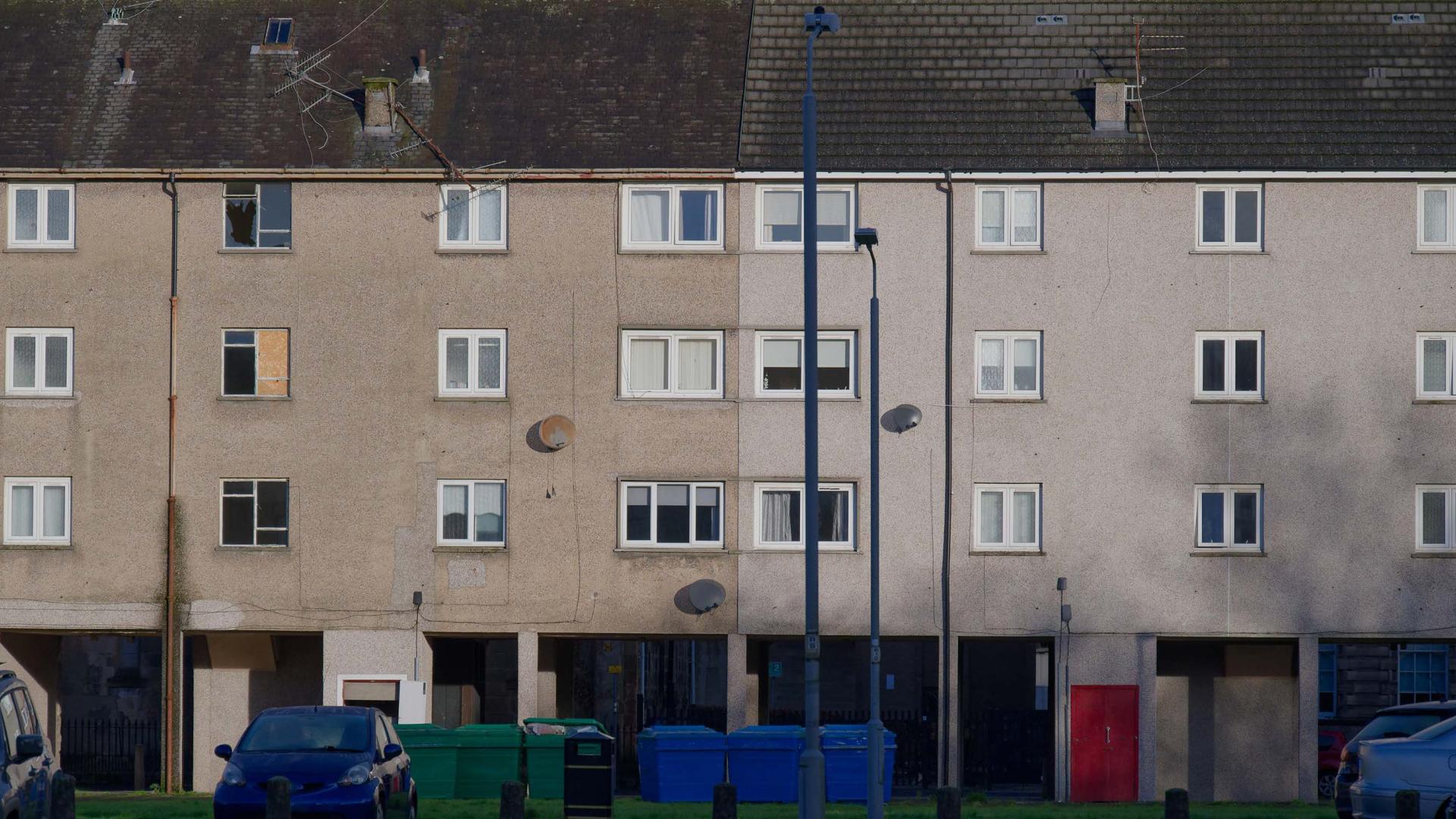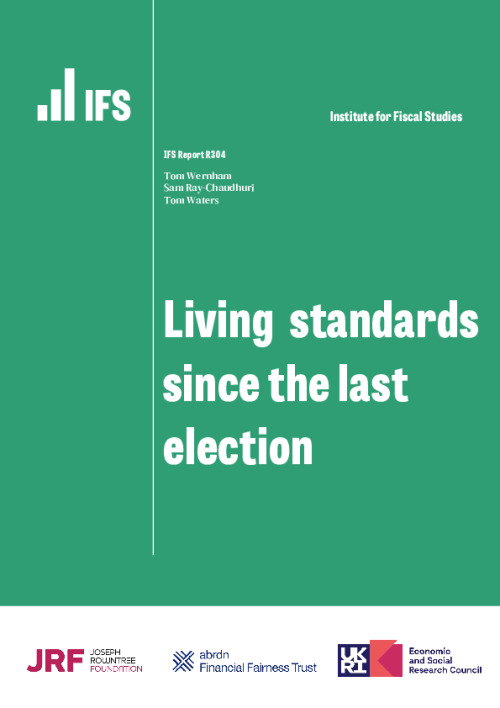Executive summary
Today, the Department for Work and Pensions released the latest official statistics on household incomes, poverty and income inequality, covering April 2022 to March 2023. As well as being the first official data on household incomes since the cost-of-living crisis reached its peak, this is also the final release before the next general election, and so is a key source for measuring how material living standards have evolved during this parliament.
This parliament has been a tumultuous one for living standards. The COVID-19 pandemic and subsequent restrictions on economic activity led to huge disruption to the economy, with knock-on effects for people’s earnings as many were furloughed or lost work. Just as the economy bounced back from the pandemic, the cost-of-living crisis hit, with inflation interrupting the recovery in real disposable income. Consequently, and in spite of the huge amount of government spending to support incomes during both crises, this parliament is on course to be the worst on record for growth in average incomes, with real incomes falling across the majority of the distribution and average disposable income growth projected by the Office for Budget Responsibility (OBR) to remain low. Moreover, whilst these figures take account of average inflation, inflationary pressures since late 2021 have not hit everyone equally (e.g. Office for National Statistics, 2024a). Digging further into other indicators of material living standards suggests that the cost-of-living crisis has been even harder for low-income families than headline income statistics suggest.
Alongside these new official data, IFS has today launched its new living standards, poverty and inequality in the UK page, featuring interactive data visualisations which showcase over 60 years of data on incomes, poverty and inequality in the UK.
Key findings
1. The cost-of-living crisis has resulted in a widespread fall in household incomes, despite the recovery in economic activity following the pandemic. Between 2021–22 and 2022–23, household income fell across all of the income distribution outside the top 20%, with a 0.5% decline at the median (middle). Measured after housing costs, median income fell by 1.5%, as rents on new lets and mortgage interest rates rose dramatically. These changes undo the recovery seen during the preceding year. As a result of the decline in incomes among poorer households, the absolute poverty rate (accounting for housing costs) rose by 0.8 percentage points to 18%.
2. Incomes fell or stagnated across the distribution between 2019–20 and 2022–23. Middle- and higher-income households have seen similar proportionate falls in income, with a 1.6% decline at the median and at the 80th percentile). Losses were smaller among poorer households, with incomes at the 20th percentile falling by 0.2%, meaning that income inequality has fallen. These figures look similar if we examine changes in incomes after deducting housing costs (with incomes falling by 1.3% at the median and 1.4% at the 80th percentile, and growing by 0.2% at the 20th percentile). That said, income growth still performed better than in the years following the 2008 financial crisis – when median income fell by more than 3%.
3. As a result, up to 2022–23, annual income growth in this parliament has been the weakest across a parliament since comparable records began in 1961 for the top two-thirds of the income distribution, and one of the worst for the bottom third. This comes on the back of poor income growth since the 2008 financial crisis. Between 2011–12 and 2019–20, median income grew by only 11.7%. Over the 15 years from 2007 to 2022, incomes grew by just 7.2% at the median, 9.9% at the 20th percentile and 3.9% at the 80th percentile.
4. The decline in household income seen over the parliament was mainly driven by a fall in workers’ real earnings. These falls were particularly substantial among those in the middle of the income distribution. Temporary support schemes such as the universal energy rebate and cost of living payments partially offset this for middle-income households, and (slightly) more than offset it for lower-income households.
5. Although absolute poverty (accounting for housing costs) declined during the pandemic (thanks in part to the temporary £20 per week uplift to universal credit), it has now returned to around its pre-pandemic level (18%, or 12 million people). This is also largely true across different groups, with the child, in-work and pensioner poverty rates all also roughly unchanged (at 25%, 14% and 12% respectively). We do see a more notable increase in absolute poverty among private renters (1.4 percentage points to 30%, or 200,000 more people) – perhaps not surprising given the rapid rise in rents for new lets, and the local housing allowance (LHA) freeze after 2019.
6. The limited change in official income poverty statistics in the year 2022–23 likely masks the fact that rising prices have disproportionately affected certain groups. This is reflected by a substantial increase in material deprivation, a measure that attempts to capture how many households are unable to afford a range of basic items (such as heating the home adequately). The rate of material deprivation (defined differently for different age groups) rose from 15% to 19% between 2019–20 and 2022–23, corresponding to an extra 2.8 million people, returning child and pensioner deprivation rates to the same level they were in 2014–15 (or 2010–11). The rate of food insecurity increased from 8% to 11% (2.1 million additional people) and the proportion unable to adequately heat their home increased from 4% to 11% (4.3 million additional people).
7. The rise in material deprivation is seen across every age group, housing tenure, work status, household composition and region – but it is especially sharp for owner-occupiers and pensioners. That material deprivation gives a much bleaker picture than income poverty likely reflects the fact that the rise in inflation has been highest among more basic goods (such as energy and food). This can be seen in the even more dramatic increases in the shares of individuals living in households with food insecurity or unable to keep their home warm.
8. These patterns pose a huge challenge for any government looking to boost living standards in the coming years. This parliament has seen the double whammy of the pandemic and the cost-of-living crisis, both of which had sharp effects on households’ purchasing power. Though the cost-of-living crisis has begun to ease, forecasts by the OBR suggest average disposable income will still be lower at the next election than it was at the last, which would make this the first parliament for decades in which average disposable income has fallen.
1. Average incomes and income inequality
To begin, we consider how average incomes have evolved up to 2022–23 (and during the cost of living crisis in particular) in the context of recent history. Figure 1 shows median, or middle, household disposable income over the last 20 years, after taxes and benefits and adjusting for inflation. In 2022–23, median income was 0.5% lower than in the previous year, 2021–22. Despite a resurgence in economic activity as the country emerged from COVID-19 restrictions in the second half of 2021–22, households saw no recovery in the real value of their incomes, as incomes failed to keep up with price rises of 10.4% from 2021–22 to 2022–23. Consequently, median income was 1.6% lower in 2022–23 than at the end of the last parliament in 2019–20. This follows more than a decade of poor income growth since the 2008 financial crisis – median disposable income grew by only 1.4% a year from 2011–12 to 2019–20. In the 15-year period from 2007–08 to 2022–23, average income rose by just 7.2% (less than 0.5% per year). Growth was also poor towards the top and bottom of the distribution, with incomes at the 20th and 80th percentiles growing by just 9.9% and 3.9% respectively after 2007–08. By contrast, in the preceding 15-year period from 1992–93 to 2007–08, average income rose by 36.4% (more than 2% per year).
We also know that some very large increases in housing costs have begun to put further pressure on those incomes. These are not yet fully reflected in the figures (median incomes after deducting housing costs actually fell by 1.3% between 2019–20 and 2022–23, slightly less than the 1.6% ‘before housing costs’ figure): although new mortgagors and renters entering new tenancies are currently facing significant increases in costs, these take time to have their full impact as households’ fixed mortgage terms expire or new tenancies start.
Short of a major turnaround, and based on OBR March forecasts of real household disposable income (Office for Budget Responsibility, 2024), this will be the worst parliament for growth in material living standards since at least 1961 – the earliest year for which we have comparable disposable income statistics. The successive economic crises of the pandemic and war in Ukraine, the knock-on effects on supply chains and the energy market, and domestic factors have had a substantial negative effect on household incomes. This is even after accounting for the huge financial support from government which went some way to mitigating these effects. It should be noted that the declines in income seen over these three years are still smaller than those in the three years after the 2008 financial crisis, so to some extent comparing over years that happen to cover a particular parliament is arbitrary.
Income growth from 2019–20 to 2022–23 was poor for households throughout the income distribution. Figure 2 highlights this poor performance by plotting the annual percentage change in income for each percentile of the income distribution, for this period and for every preceding parliament since 1961, where each parliament (except very short ones) is represented by a line. (The 10th percentile of the income distribution is defined such that 10% of people had a household income less than this and 90% had more.)
The declines in income between 2019–20 and 2022–23 have been similar for the top two-thirds of the income distribution, and it is only towards the bottom of the distribution that incomes have not fallen (or have grown). The period has therefore been an income-inequality-reducing one when measured in these terms, albeit only because while incomes performed very poorly at the bottom, they did even worse in the middle and at the top.
With forecasts suggesting that a rapid turnaround since 2022–23 is unlikely, this is likely to be among the worst parliaments for income growth on record for most of the income distribution. Some previous parliaments have seen very low growth towards the bottom or towards the top, but no parliament has seen such comprehensively poor performance across the distribution of incomes.
If we instead measure incomes after deducting housing costs, the picture is slightly improved, but still bleak (click on the chart to see incomes after deducting housing costs). A fall in average housing costs between 2019–20 and 2022–23 meant the declines in income in the middle and at the top were not so stark, and towards the bottom of the distribution there was some growth in incomes after housing costs are deducted. However, the significant increases in housing costs for those households taking out new mortgages or re-mortgaging are not well measured in the data, meaning this analysis is likely to understate the extent to which income after deducting housing costs has fallen for some households. With mortgage rates remaining high, and rents on new lets having grown considerably, it is likely housing costs will continue to be a drag on growth in households’ disposable incomes going forward.
What has driven changes in income?
Next we explore what has been behind these falls in income in more detail. Figure 3 decomposes falls in mean (rather than median) income from 2019–20 to 2022–23 into the contributions from changes in work earnings, benefits, temporary cost-of-living support and other income sources. This exercise is performed overall, and for the lowest-, middle- and highest-income thirds of the population separately.
The prime driver of falling incomes was declines in real net earnings from employment (or self-employment), contributing on average to a 1.5% fall in income. This was a result of rising economic inactivity, earnings failing to keep pace with inflation, and frozen tax thresholds increasing real tax liabilities (though cuts to National Insurance will have reversed this for many by the end of the parliament). Falling net earnings were most significant for the middle third, followed by the bottom third (of whom fewer households are in work), whereas the top third actually saw a small rise in net real earnings.
Average benefit income also fell in real terms for the poorest third. This is partly because benefits are uprated annually based on a lagged measure of inflation, and so fail to keep pace with prices when inflation rises. With inflation now falling, this effect will have almost reversed by 2024–25. The fall in benefit income due to the uprating effect is slightly offset by a rise in the amount of disability benefits received, a trend visible at all income levels. This is not driven by any increase to the generosity of disability benefits, and to the extent that this change reflects an increase in disability prevalence it is a worrying sign. On the other hand, benefit income contributed a 1.3% increase in income for households in the middle third of the income distribution. Higher disability benefits, and the cut in the universal credit taper rate from 63% to 55% – which benefits in-work households – have both played a role in this pattern.
In 2022–23, several cost-of-living payments were introduced for those on the state pension, means-tested benefits and disability benefits, to offset the impact of lagged uprating, while further payments were made through council tax and energy bills. These mostly targeted payments explain why incomes were almost maintained in real terms for the poorest third. Looking at incomes after deducting housing costs, declining housing costs for the poorest and middle thirds in particular provided a further boost to disposable incomes on average. Though rents rose considerably on new lets and mortgage interest rates increased, both these forces take time to feed through to the whole population, meaning the effect was not felt widely in 2022–23, and on average housing costs rose more slowly than other prices. Going forwards, this boost is likely to be reversed as more are hit by rising rents and mortgage interest payments (click on the chart to see the decomposition of after-housing-costs incomes).
2. Poverty and deprivation
Having considered trends across the distribution, we now explore how the material living standards of those on lower incomes have fared over the parliament. We already know that the pandemic reduced income poverty because of the lower exposure to labour market disruption of lower-income households and the support made available through the benefits system (Cribb et al., 2022). But more recently, attention has been paid to the fact that the cost-of-living crisis has not hit all households equally, with different cost pressures, and different trends in income, affecting richer and poorer households.
In 2022–23, the share of people in absolute income poverty (measured after deducting housing costs), defined as those with household income below a fixed real-terms poverty line (£15,600 per year for a childless couple), returned to its 2019–20 level of 18%, or 12 million people. This marked an increase from less than 17% during the pandemic, when benefit levels were temporarily increased, corresponding to an additional 750,000 people living in absolute poverty. Though real employment earnings and benefit income fell over the period, the cost-of-living payments offset this fall for lower-income households on average. Relative poverty, the proportion of individuals with household income below 60% of the contemporaneous median, has fallen slightly to 21% over the parliament, down from 22% (a reduction of 400,000, to 14.3 million) but this is driven by median incomes falling rather than by low incomes rising. All this is to be expected from Figure 2, which showed real incomes at the bottom of the distribution little changed since 2019–20, while median income (and hence the relative poverty line) has fallen. Over relatively short periods, it is absolute changes in living standards that are likely most useful when assessing poverty trends.
The group that fared best on these poverty measures was pensioners. For this period, absolute poverty for them was roughly flat, falling about half a percentage point (by 100,000, to 1.45 million people), while relative poverty fell by almost 2 percentage points (by 250,000, to 1.9 million people). Above-inflation state pension indexation, combined with cost-of-living payments targeted at pensioners and pension credit recipients, has boosted the real incomes (as measured in the official statistics) of poorer pensioners.
The unusual circumstances of the cost-of-living crisis mean that over this parliament, incomes and poverty rates reported in official statistics might not be as reliable an indicator of material living standards as usual, especially in the case of poorer households. A key reason for this is that, whilst incomes are adjusted for the overall rate of inflation, the large price changes during the cost-of-living crisis have not affected all households equally. High inflation has been driven particularly by energy and food prices, and these goods make up larger shares of the budgets of certain groups, such as those on lower incomes and pensioners. This means these groups have effectively faced a higher rate of inflation than other members of the population (e.g. Office for National Statistics, 2024a and 2024b). Moreover, housing costs (which we deduct from incomes when measuring poverty) for owner-occupiers with mortgages are not directly measured – rather, they are imputed assuming everyone faces the same, average mortgage interest rate. This will reflect the average rise in housing costs, but fails to capture the fact that some mortgaged households will have faced large increases in costs as their interest rates jumped up. Hence, poverty rates calculated based on the official methodology will likely understate any decline in living standards these groups faced due to the cost-of-living crisis.
As a result, it is informative to examine some of the other key measures in today’s data. Figure 6 shows, for various demographic groups, how three of these metrics have evolved over the parliament, and compares these changes with those in absolute poverty. These measures are the rates of material deprivation, food insecurity and inability to keep one’s home adequately warm (see Box 1 for more detail on these measures). Hover over the dots to see the numbers of people.
Box 1. Measures of low living standards
Figure 6 shows four different indicators of low living standards. These are:
- Absolute poverty – this is the proportion of people with household net income (after deducting housing costs) below a poverty line that is fixed over time (in real terms, i.e. after adjusting for inflation) at £15,600 per year for a childless couple. Since this measure only uses average inflation, it may understate any declines in living standards caused by the cost-of-living crisis for certain groups, e.g. pensioners and those on low incomes.
- Material deprivation – this measure, which feeds into statistics reported in the official HBAI publication, gives the share of people who lack a number of essential goods (e.g. fresh fruit and vegetables or ability to heat the home adequately), for reasons other than not wanting them. Different goods and methodologies are used for working-age adults, pensioners and children. Here we report the proportion in deprivation according to the relevant definition for their respective age group. Note we do not use the combined measure of material deprivation and low income reported in the government’s HBAI publication. For more detail, see Department for Work and Pensions (2024).
- Food insecurity – this measures the proportion of individuals in households who have significantly reduced the quantity, quality, variety or desirability of their food intake in the 30 days prior to interview.
- Inability to warm home – this gives the proportion of individuals living in households that report they are not able to keep their home adequately warm. This is one of the items measured as part of material deprivation.
Figure 6 shows that, despite no change in absolute poverty, there is evidence of a significant increase in hardship in 2022–23 compared with the end of the last parliament. The rate of food insecurity increased from 8% to 11% (increasing by 2.1 million to 7.3 million), the proportion unable to adequately heat their home increased from 4% to 11% (increasing by 4.3 million to 7.2 million) and the rate of material deprivation (defined for each individual according to the measure for their respective age group) increased from 15% to 19% (increasing by 2.8 million to 13 million). This leaves the share of people without an adequately warm home higher than at any point in the 2010s, and reverses the trend of declining child and pensioner material deprivation rates seen during the same period, returning them to 21% and 8% respectively – about the same level as in 2014–15, and indeed 2010–11. This suggests that differential inflation has had a significant impact on the living standards of those on lower incomes, which is not reflected in the income statistics. Perhaps most notable is how widespread these increases in deprivation were across different demographic groups.
Nevertheless, some groups were hit harder than others. One particularly hard-hit group was pensioners, for whom the proportion unable to heat their home more than doubled to 5% (or 600,000). Clearly, many low-income pensioners have struggled due to rising energy and food costs, despite the fact this group received targeted additional support through cost-of-living payments. There were also significant differences between households of different tenure types. The share of owner-occupiers with mortgages experiencing food insecurity doubled, and the proportion unable to adequately heat their homes more than tripled, though renters remained more deprived on these measures on average (click the button on the chart to see deprivation by housing tenure).
It is important to note that since 2022–23, inflation has been lower for poorer households than the average (Office for National Statistics, 2024a). Energy prices in particular have fallen substantially (Office for National Statistics, 2024b), which is likely to have reduced cost pressures for poorer and older households. Consequently, this divergence between income-based measures of low living standards and alternative measures may well at least partially reverse.
3. Conclusion
This parliament so far has been a dismal one for material living standards, a significant challenge for the next government. The extent of falling and stagnating real incomes over a single parliament is unprecedented in the six decades for which comparable statistics are available (though the years after the 2008 financial crisis saw larger falls). The poor performance of living standards comes on the back of poor income growth since 2007: median incomes grew by only 7% over the 15 years from 2007 to 2022.
Moreover, given the particular nature of the cost-of-living crisis, it is likely that the official income statistics measured in the usual way actually understate how badly living standards have deteriorated for the poorest parts of the population. There is evidence from other measures that this group, along with pensioners, has suffered more than income poverty statistics suggest.
Looking to 2023–24 and the final months of the parliament, it is difficult to predict how well living standards will recover from the significant hit experienced during the cost-of-living crisis, but there is a significant chance they will remain lower on average than at the beginning of the parliament. On the one hand, inflation has fallen, and energy prices in particular have reduced considerably (Office for National Statistics, 2024b), while real earnings growth has returned, and taxes have been cut for middle- and upper-middle earners (Adam et al., 2024). Benefits are set to rise faster than inflation in April, compensating for the withdrawal of cost-of-living payments, and the state pension even faster as a result of the triple lock. On the other hand, taxes have risen for lower earners and pensioners over the parliament, food price inflation remains higher, and rising rents on new lets and higher mortgage interest rates mean renters entering new tenancies and those coming to the end of fixed-rate mortgages are likely to see further increases in their housing costs.
All this presents significant challenges for the incoming government, with the OBR forecasting that real incomes are unlikely to return to 2019 levels until 2025. The options for turning things around are limited, given the lack of scope to cut personal taxes or increase benefits due to the public finance challenges. Incomes have risen very little right across the income distribution for a period of 15 years now and, without greater-than-expected growth in national income per capita, that is unlikely to change soon.
References
Adam, S., Emmerson, C., Johnson, P., Joyce, R., Miller, H., Stockton, I., Wernham, T.,. and Zaranko, B., 2024,. Spring Budget 2024: initial IFS response. IFS Comment, https://ifs.org.uk/articles/spring-budget-2024-initial-ifs-response.
Cribb, J., Waters, T., Wernham, T. and Xu, X., 2022. Living standards, poverty and inequality in the UK: 2022. IFS Report R215, https://ifs.org.uk/publications/living-standards-poverty-and-inequality-uk-2022.
Department for Work and Pensions, 2024. Households below average income series: quality and methodology information report FYE 2023. https://www.gov.uk/government/statistics/households-below-average-income-for-financial-years-ending-1995-to-2023/households-below-average-income-series-quality-and-methodology-information-report-fye-2023.
Office for Budget Responsibility, 2024. Economic and fiscal outlook – March 2024. https://obr.uk/efo/economic-and-fiscal-outlook-march-2024/.
Office for National Statistics, 2024a. Household costs indices for UK household groups: October 2023 to December 2023. https://www.ons.gov.uk/economy/inflationandpriceindices/bulletins/householdcostsindicesforukhouseholdgroups/october2023todecember2023.
Office for National Statistics, 2024b. Cost of living latest insights. https://www.ons.gov.uk/economy/inflationandpriceindices/articles/costofliving/latestinsights.












